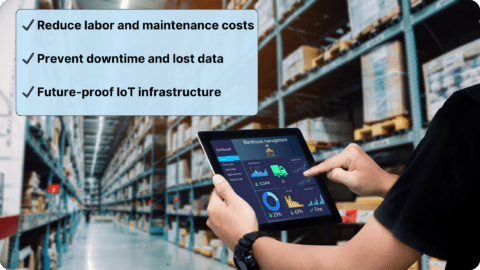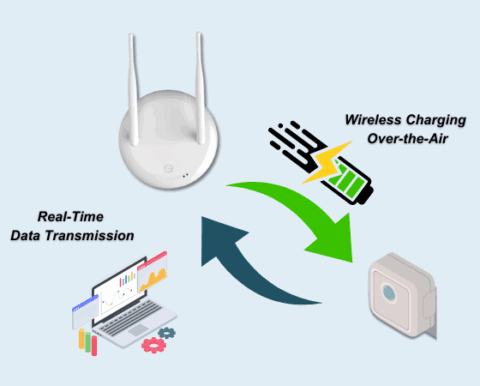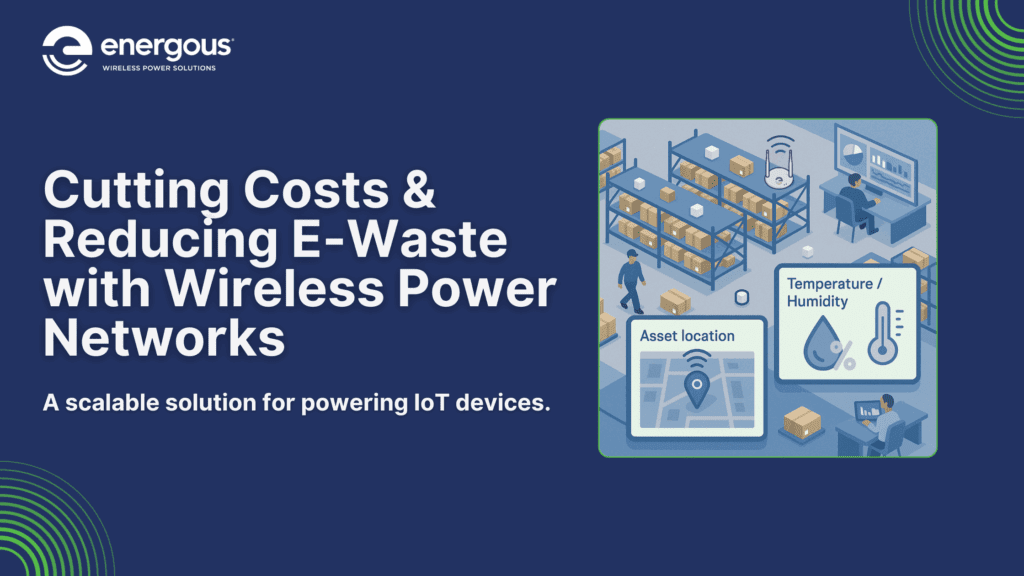The Internet of Things (IoT) is experiencing exponential growth. By 2030, the number of connected IoT devices is expected to reach 40 billion. This explosion of devices presents a critical challenge: how do we keep them powered efficiently without generating massive amounts of e-waste?
Many IoT devices, such as sensors, rely on traditional batteries, which may seem convenient but actually come with hidden costs. Battery replacements increase labor expenses, cause operational downtime, and contribute to environmental waste. As businesses expand their IoT deployments to automate certain operational processes such as asset tracking, battery maintenance becomes an increasingly complex issue—leading to data gaps, lost visibility, and unexpected failures when devices run out of power.
The True Cost of Battery Maintenance
Keeping battery-powered IoT devices running isn’t just a logistical challenge—it’s a costly and unsustainable problem. Here’s why:
• Labor Costs Add Up: Changing thousands of batteries across an industrial setting is time-consuming and expensive.
• Downtime Leads to Data Loss: When a battery dies, asset tracking, environmental monitoring, and critical operations can be disrupted.
• E-Waste & Compliance Costs Are Rising: Disposing of used batteries isn’t free. Regulations around battery recycling are becoming stricter, adding further costs to businesses.
To put this into perspective, an industrial company with 10,000 IoT devices could spend approximately $6 million over five years on battery replacements alone, with each device costing an average of $300 per replacement (QOITech).
Beyond the financial considerations, governments worldwide are tightening regulations on battery waste. The EU Batteries Regulation 2023/1542 mandates higher recycling rates and restricts disposable batteries in certain industries. (Learn more about EU Battery Regulations)
As more restrictive regulations emerge, companies that continue to rely on disposable batteries will face higher compliance costs and operational risks. The good news? Wireless Power Networks (WPNs) can eliminate these challenges altogether. By cutting out the need for battery-powered devices, businesses can reduce maintenance costs, avoid operational disruptions, and future-proof themselves from evolving environmental regulations.
How Wireless Over-the-Air Power Works
WPNs make over-the-air energy delivery a practical reality for IoT. These networks consist of RF-based transmitters and receivers that work together to wirelessly deliver power to IoT devices and seamlessly transmit valuable data to the cloud, eliminating the need for batteries or wired connections.
Unlike traditional wireless power methods that require close-range charging pads, WPNs can send power over varying distances and to multiple devices simultaneously. This is made possible through safe, efficient radio frequency (RF) transmission—an ideal method for keeping low-power sensors and devices continuously charged.

By integrating power and data into one streamlined network, WPNs enable businesses to scale their IoT deployments all at a minimal total cost of ownership.
Unique Integrations from Energous
Beyond standard wireless charging capabilities, Energous’ WPN technology offers features that go beyond charging:
• Integrated RF + BLE Functionality: Energous transmitters combine radio frequency (RF) power delivery with Bluetooth Low Energy (BLE) communication, enabling seamless data transfer and real-time device interaction—all through a single unit.
• Always-On Power Delivery: With consistent over-the-air energy transmission, devices stay powered 24/7 without the need for battery swaps or recharging cycles.
• Remote Power Management: The system allows for centralized control and monitoring of power distribution, making it easy to configure, troubleshoot, and optimize WPN performance at scale.

Think of it like Wi-Fi—but instead, it transmits power & data, keeping devices running without the hassle of battery swaps.
Where Wireless Power Networks Have the Biggest Impact
Not all industries can afford the risks associated with battery-powered IoT devices. WPNs are particularly valuable in sectors where battery maintenance is costly, disruptive, or impractical:
• Asset Tracking: Prevents data loss by ensuring continuous monitoring of valuable equipment and inventory.
• Cold Chain Monitoring: Keeps temperature and humidity sensors running without interruption, reducing spoilage risks.
• Warehousing & Logistics: Eliminates downtime caused by battery failures in inventory tracking and environmental monitoring.
By integrating wireless power solutions into these industries, companies can significantly cut costs, improve efficiency, and ensure uninterrupted operations.
The Future of IoT Is Over-the-Air
The growing number of IoT devices deployed means the cost and complexity of maintaining battery-powered sensors will only increase. With rising labor costs, data loss risks, and strict e-waste regulations, businesses must rethink how they power their IoT ecosystems.
WPN solutions eliminate the need for battery maintenance, offering a scalable, cost-effective, and regulation-proof solution for the future.
The transition to wireless power simultaneously drives cost savings and creates a more efficient, sustainable, and futureproof IoT ecosystem.
Ready to power your IoT devices wirelessly? Schedule a meeting with an expert today.


